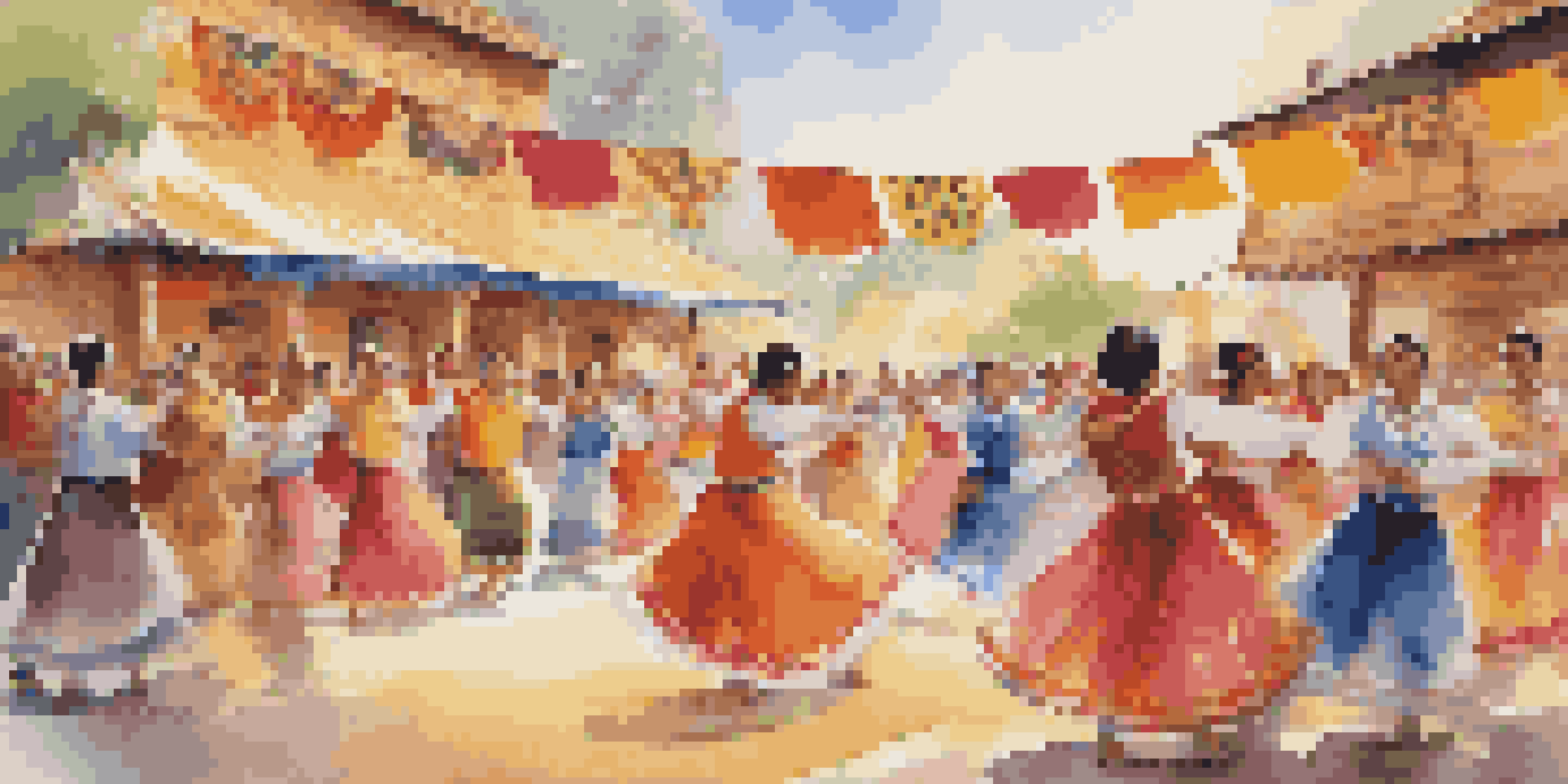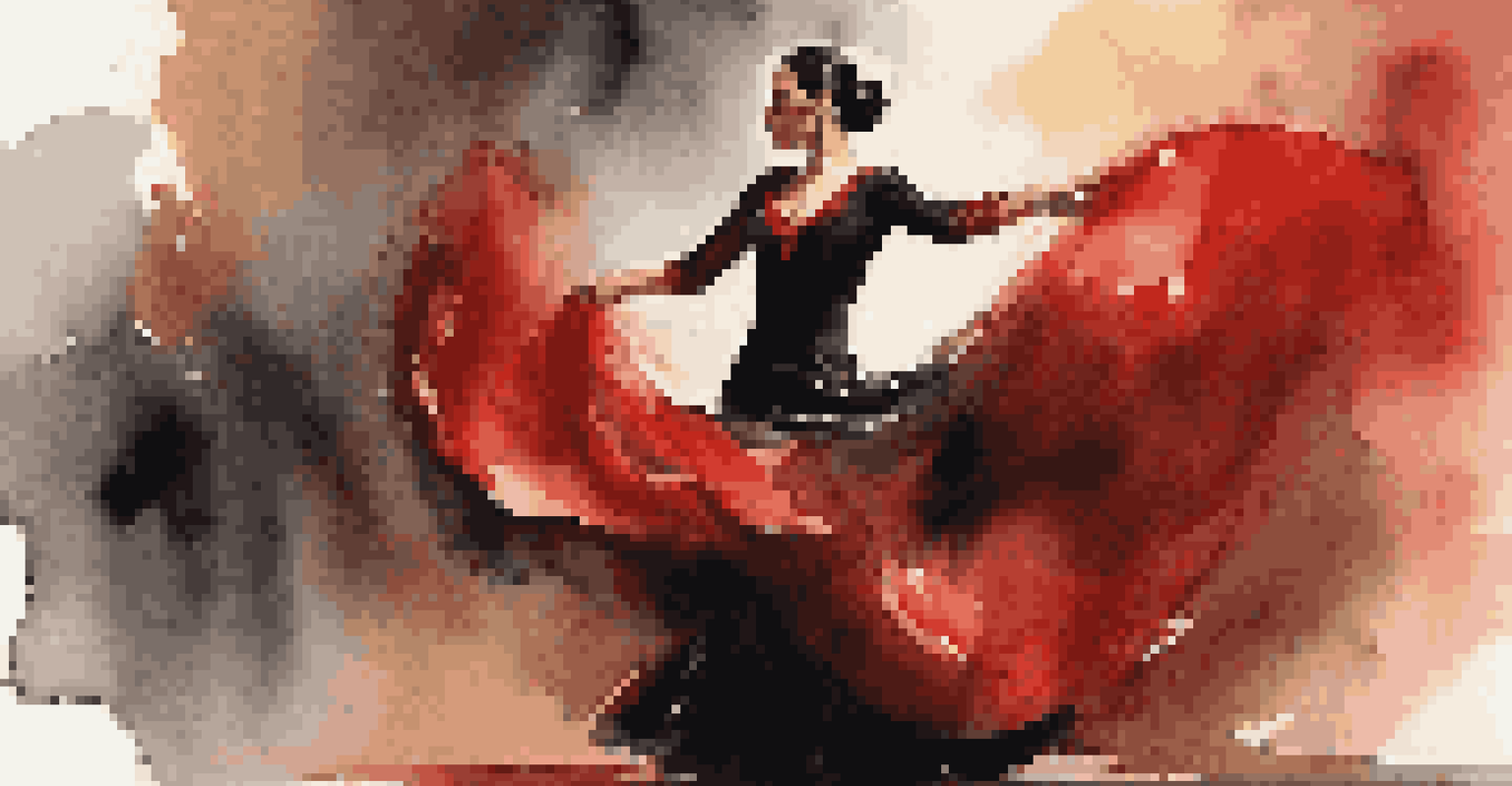Cultural Festivals: Dance as a Reflection of Heritage

Understanding the Role of Dance in Cultural Festivals
Dance has long been a vital expression of culture, serving as a medium through which stories, values, and traditions are conveyed. At cultural festivals, dance allows communities to showcase their unique identities while celebrating their shared heritage. Whether it's a vibrant folk dance or a solemn ceremonial performance, each movement tells a story that resonates with the audience.
Dance is the hidden language of the soul.
For instance, traditional dances often incorporate elements that reflect the history and struggles of a community. These performances can evoke a sense of pride and belonging, reminding participants and spectators alike of their roots. Thus, dance becomes a powerful tool for preserving cultural narratives in an ever-changing world.
Moreover, the interactive nature of dance encourages audience participation, making it a communal experience. This engagement not only enhances the enjoyment of the festival but also fosters a deeper understanding of the cultural significance of the dances being performed. In essence, dance at cultural festivals encapsulates the spirit of community and heritage.
Diverse Dance Forms and Their Cultural Significance
Different cultures around the world have their unique dance forms, each rich with meaning and history. For example, the Flamenco of Spain is not just a dance; it's an emotional expression of passion and pain, rooted in the experiences of the Andalusian people. Similarly, the Maori haka from New Zealand showcases strength and unity, often performed during significant events to honor ancestors.

These diverse dance forms serve as a means of cultural storytelling, where movements, costumes, and music intertwine to create a vivid tapestry of tradition. The distinct styles reflect the values and experiences of the communities they originate from, making them invaluable cultural treasures. Through these performances at festivals, dancers pass down their heritage to future generations.
Dance Celebrates Cultural Heritage
Dance serves as a vital expression of culture, showcasing unique identities and preserving shared traditions at cultural festivals.
Furthermore, the globalization of cultural festivals has led to a beautiful exchange of dance styles, allowing for new interpretations and hybrid forms. While this may introduce modern influences, it also highlights the adaptability and resilience of cultural practices. The blend of different dance forms at festivals enriches the experience for everyone involved.
Emotional Connection: Dance as a Medium of Expression
Dance is not only a visual art form but also a profound emotional experience. When performed, it evokes feelings of joy, nostalgia, and sometimes even sorrow, resonating deeply with both dancers and audiences. This emotional connection is particularly evident during cultural festivals, where the atmosphere is often charged with energy and excitement.
The dance is a poem of which each movement is a word.
For instance, during the Diwali festival in India, dancers often perform traditional dances celebrating light and victory over darkness. The joy and celebration in their movements can uplift the spirits of onlookers, creating a shared atmosphere of happiness. This emotional exchange enhances the overall festival experience and strengthens community bonds.
Moreover, dance allows individuals to express their personal stories within the framework of cultural heritage. Dancers might incorporate their own experiences into traditional movements, blending personal narratives with collective history. This fusion not only honors tradition but also adds layers of meaning to each performance, making it a unique and memorable experience.
The Impact of Cultural Festivals on Community Identity
Cultural festivals play a crucial role in shaping and reinforcing community identity. Through dance and other forms of expression, these events bring people together, helping to foster a sense of belonging and pride. They serve as a reminder of shared values, traditions, and histories that bind individuals within a community.
For example, the Carnaval in Brazil is not just a celebration of music and dance; it's a manifestation of Brazilian identity, showcasing the country's diverse cultural influences. The samba dancers represent the spirit and resilience of the people, reinforcing their connection to their heritage. Such festivals affirm the importance of cultural identity in an increasingly globalized world.
Emotional Bonds Through Dance
Cultural festivals create emotional connections through dance, enhancing community bonds and allowing personal stories to intertwine with cultural heritage.
Moreover, cultural festivals often attract visitors from outside the community, providing an opportunity to educate others about their unique traditions. This sharing fosters intercultural understanding and appreciation, allowing communities to shine on a broader stage. In this way, dance and cultural festivals become vital in promoting community identity and pride.
Preserving Tradition through Dance in Modern Times
As society evolves, there is often a tension between modernity and tradition. Cultural festivals that feature dance are essential in preserving traditional practices while adapting to contemporary contexts. This ensures that heritage is not lost but instead evolves in a way that remains relevant to newer generations.
For instance, many communities incorporate modern music or technology into traditional dances, creating a fusion that attracts younger audiences. This approach not only keeps the art form alive but also sparks interest in cultural heritage. By reinterpreting traditional dances, communities can engage with their youth while honoring their past.
Additionally, educational programs and workshops at cultural festivals can help teach younger generations about their ancestral dances. These initiatives ensure that the knowledge and skills associated with these art forms are passed down, creating a sustainable future for cultural practices. In essence, dance becomes a living tradition that adapts while maintaining its core values.
The Role of Technology in Cultural Dance Preservation
In today's digital age, technology plays a significant role in preserving and promoting cultural dances. Online platforms allow communities to share their dance performances, tutorials, and stories with a global audience, breaking geographical barriers. This accessibility not only fosters appreciation for diverse cultures but also encourages participation in traditional dances.
For example, social media has become a powerful tool for cultural promoters to showcase dance at festivals, reaching audiences far beyond their local communities. Dance videos can go viral, inspiring others to learn and participate in cultural celebrations. This phenomenon helps maintain cultural relevance in a fast-paced world.
Technology Preserves Dance Traditions
In the digital age, technology facilitates the preservation and promotion of cultural dances, ensuring they remain relevant and accessible to future generations.
Moreover, technology can aid in archiving traditional dance forms, ensuring that they are not forgotten. Virtual reality and augmented reality experiences offer immersive ways to engage with cultural heritage, allowing users to experience dances from different cultures firsthand. By integrating technology into cultural preservation efforts, communities can ensure that their rich heritages continue to thrive in future generations.
Conclusion: Celebrating Heritage through Dance
Cultural festivals serve as a vibrant canvas where dance and heritage intertwine, creating a rich tapestry of community expression. Through the lens of dance, we witness the stories, struggles, and triumphs of people across the globe. These celebrations not only honor the past but also pave the way for the future of cultural identity.
As we engage with dance at cultural festivals, we participate in a collective celebration that transcends generations. We learn from one another, appreciate diversity, and foster connections that enrich our lives. In doing so, we contribute to the ongoing legacy of culture and heritage.

Ultimately, embracing dance as a reflection of heritage allows us to keep traditions alive while inviting innovation. By celebrating and preserving these art forms, we ensure that the spirit of our communities continues to shine brightly for years to come.